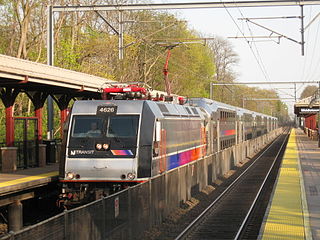
Commuter rail, or suburban rail, is a passenger rail transport service that primarily operates within a metropolitan area, connecting commuters to a central city from adjacent suburbs or commuter towns. Commuter rail systems are considered heavy rail, using electrified or diesel trains. Distance charges or zone pricing may be used.

Poetry, also called verse, is a form of literature that uses aesthetic and often rhythmic qualities of language − such as phonaesthetics, sound symbolism, and metre − to evoke meanings in addition to, or in place of, a prosaic ostensible meaning. A poem is a literary composition, written by a poet, using this principle.

Standard-definition television is a television system which uses a resolution that is not considered to be either high or enhanced definition. "Standard" refers to offering a similar resolution to the analog broadcast systems used when it was introduced.

In astronomy, stellar classification is the classification of stars based on their spectral characteristics. Electromagnetic radiation from the star is analyzed by splitting it with a prism or diffraction grating into a spectrum exhibiting the rainbow of colors interspersed with spectral lines. Each line indicates a particular chemical element or molecule, with the line strength indicating the abundance of that element. The strengths of the different spectral lines vary mainly due to the temperature of the photosphere, although in some cases there are true abundance differences. The spectral class of a star is a short code primarily summarizing the ionization state, giving an objective measure of the photosphere's temperature.

The Paris Métro and operated by the Régie autonome des transports parisiens (RATP) is a rapid transit system in the Paris metropolitan area, France. A symbol of the city, it is known for its density within the capital's territorial limits, uniform architecture and unique entrances influenced by Art Nouveau. The system is 226.9 kilometres (141.0 mi) long, mostly underground. It has 308 stations of which 64 have transfers between lines. There are 16 lines, numbered 1 to 14, with two lines, 3bis and 7bis, named because they started out as branches of Line 3 and Line 7, respectively. Line 1, Line 4 and Line 14 are automated. Lines are identified on maps by number and colour, with the direction of travel indicated by the terminus.
Delta Air Lines is one of the major airlines of the United States and a legacy carrier. One of the world's oldest airlines in operation, Delta is headquartered in Atlanta, Georgia. The airline, along with its subsidiaries and regional affiliates, including Delta Connection, operates over 5,400 flights daily and serves 325 destinations in 52 countries on six continents. Delta is a founding member of the SkyTeam airline alliance. As of the end of 2022, it had 90,000 employees.
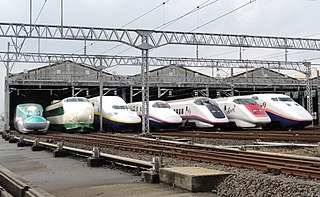
The Shinkansen, colloquially known in English as the bullet train, is a network of high-speed railway lines in Japan. Initially, it was built to connect distant Japanese regions with Tokyo, the capital, to aid economic growth and development. Beyond long-distance travel, some sections around the largest metropolitan areas are used as a commuter rail network. It is owned by the Japan Railway Construction, Transport and Technology Agency and operated by five Japan Railways Group companies.
Swiss International Air Lines AG, colloquially known as SWISS, is the flag carrier of Switzerland and a subsidiary of the Lufthansa Group. It operates scheduled services in Europe and to North America, South America, Africa and Asia. Zurich Airport serves as its sole hub and Geneva Airport as a focus city. The airline was formed following the bankruptcy in 2002 of Swissair, Switzerland's then-flag carrier. The new airline was built around what had been Swissair's regional subsidiary, Crossair. Swiss retains Crossair's IATA code LX. It assumed Swissair's old ICAO code of SWR, to maintain international traffic rights. It is a member of Star Alliance and a subsidiary of the Lufthansa Group. Its headquarters are at EuroAirport Basel Mulhouse Freiburg near Basel, Switzerland, and an office at Zurich Airport in Kloten, Switzerland. The company's registered office is in Basel.
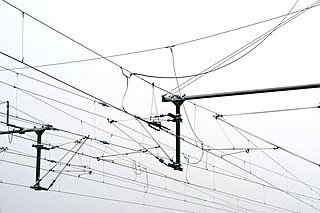
An overhead line or overhead wire is an electrical cable that is used to transmit electrical energy to electric locomotives, trolleybuses or trams. The generic term used by the International Union of Railways for the technology is overhead line. It is known variously as overhead catenary, overhead contact line (OCL), overhead contact system (OCS), overhead equipment (OHE), overhead line equipment, overhead lines (OHL), overhead wiring (OHW), traction wire, and trolley wire.
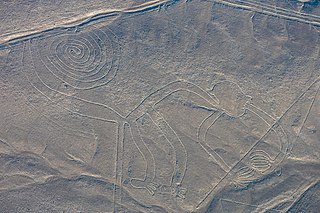
The Nazca Lines are a group of geoglyphs made in the soil of the Nazca Desert in southern Peru. They were created between 500 BC and 500 AD by people making depressions or shallow incisions in the desert floor, removing pebbles and leaving different-colored dirt exposed. There are two major phases of the Nazca lines, Paracas phase, from 400 to 200 BC, and Nazca phase, from 200 BC to 500 AD. In the years leading up to 2020, between 80 and 100 new figures had been found with the use of drones, and archaeologists believe that there are more to be found.
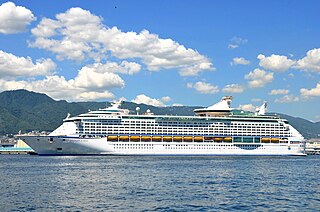
Cruise ships are large passenger ships used mainly for vacationing. Unlike ocean liners, which are used for transport, cruise ships typically embark on round-trip voyages to various ports of call, where passengers may go on tours known as "shore excursions". On "cruises to nowhere" or "nowhere voyages", some cruise ships make two- to three-night round trips without visiting any ports of call.

A contour line of a function of two variables is a curve along which the function has a constant value, so that the curve joins points of equal value. It is a plane section of the three-dimensional graph of the function parallel to the -plane. More generally, a contour line for a function of two variables is a curve connecting points where the function has the same particular value.

A branch line is a secondary railway line which branches off a more important through route, usually a main line. A very short branch line may be called a spur line. Branch lines may serve one or more industries, or a city or town not located on a main line. Branch lines may also connect two or more main lines.

720p is a progressive HD signal format with 720 horizontal lines/1280 columns and an aspect ratio (AR) of 16:9, normally known as widescreen HD (1.78:1). All major HD broadcasting standards include a 720p format, which has a resolution of 1280×720p.
1080i is a combination of frame resolution and scan type. 1080i is used in high-definition television (HDTV) and high-definition video. The number "1080" refers to the number of horizontal lines on the screen. The "i" is an abbreviation for "interlaced"; this indicates that only the even lines, then the odd lines of each frame are drawn alternately, so that only half the number of actual image frames are used to produce video. A related display resolution is 1080p, which also has 1080 lines of resolution; the "p" refers to progressive scan, which indicates that the lines of resolution for each frame are "drawn" on the screen in sequence.

480i is the video mode used for standard-definition digital video in the Caribbean, Japan, South Korea, Taiwan, Philippines, Western Sahara, and most of the Americas. The other common standard definition digital standard, used in the rest of the world, is 576i.

An overhead power line is a structure used in electric power transmission and distribution to transmit electrical energy across long distances. It consists of one or more uninsulated electrical cables suspended by towers or poles.
High-definition television describes a television system which provides a substantially higher image resolution than the previous generation of technologies. The term has been used since 1936; in more recent times, it refers to the generation following standard-definition television (SDTV), often abbreviated to HDTV or HD-TV. It is the current de facto standard video format used in most broadcasts: terrestrial broadcast television, cable television, satellite television and Blu-ray Discs.

Rapid transit or mass rapid transit (MRT), also known as heavy rail or metro, is a type of high-capacity public transport that is generally built in urban areas. A rapid transit system that primarily or traditionally runs below the surface may be called a subway, tube, or underground. Unlike buses or trams, rapid transit systems are railways, usually electric, that operate on an exclusive right-of-way, which cannot be accessed by pedestrians or other vehicles. They are often grade-separated in tunnels or on elevated railways.

"Blurred Lines" is a song by American singer Robin Thicke featuring fellow American musicians T.I. and Pharrell Williams from the former's sixth studio album of the same name (2013). Solely produced by the latter, it was released as the album's lead single in 2013, through Star Trak Recordings and Interscope Records. For the lyrics, Thicke said the song is about his then-wife Paula Patton. Musically, "Blurred Lines" is an R&B and pop track with instrumentation consisting of bass guitar, drums, and percussion.














